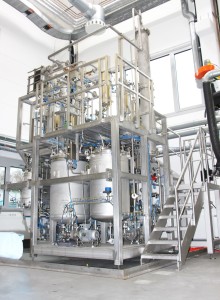Most of today’s fresh as well as convenience food is sold in plastic packages. These packages need to account for a number of functions such as preserving hygienic conditions or enabling long shelf-life. Although many plastic packages can be recycled today, most are still based on fossil sources. In order to reduce the environmental impact of plastic packaging, the HyperBioCoat project aims at developing innovative coatings for bioplastics that are not only biobased but also fully biodegradable.
Biodegradable packaging materials have been on the market for a long time. However, there are severe restrictions preventing their broad use in food packaging, as for several applications these materials do not provide the requested properties, such as a sufficient barrier against water vapour, oxygen or flavours. The idea of the project is thus to improve the properties of bioplastics by a biodegradable and sustainable coating for food, cosmetics and medical applications. Importantly, the raw materials of the coating do not compete with food production.
Biobased and biodegradable coatings with full functionality
The project consortium, consisting of 12 partners from research and industry, will combine the high-performance bioORMOCER® concept, developed by Fraunhofer ISC, with oligomeric hemicellulose feedstock. In particular, the polymeric structures of hemicelluloses are exploited. By the use of these biopolymers, organoalkoxysilanes will be substituted to obtain a biobased and biodegradable functional coating material.
Within the project, the Fraunhofer Research Institution for Materials Recycling and Resource Strategies IWKS in Alzenau (Bavaria) and Hanau (Hesse) is working on the extraction and chemical modification of certain polysaccharides, mainly hemicellulose, as basis for the new coatings. For the extraction, the researchers use an extractor at pilot scale and pre-treated fruit residues from juice or pectin production, e.g. from apples or raspberries. To extract hemicelluloses, the extractor is operated with alkali or hot water. After the precipitation of the hemicelluloses with alcohol these are modified to meet the high functional requirements of bioORMOCER® coatings. The high accessibility for functionalization and therefore for modification is predestined to integrate hemicelluloses in further coating concepts.
The project aims at high barrier performance against water vapour, oxygen or flavours. For example, the Oxygen Transmission Rate (OTR) needs to be smaller than 1 cm3/(m2·d·bar) at 23ºC and 50% relative humidity, while Water Vapor Transmission Rate (WVTR) should not exceed 1 g/(m2·d) at 23ºC and 85% relative humidity.

First milestones achieved
The researchers were able to successfully incorporate hemicelluloses extracted from cocoa hulls, raspberry pomace or depectinised apple pomace in bioORMOCER® lacquers and to scale up hemicellulose extraction from apple pomace. This marks two important milestones achieved in the project. The next step will be to demonstrate that hemicelluloses from the specified sources meet the performance requirements of bioORMOCER® coatings.
The coating itself is implemented via an automated coating methodology using a robotic arm with spray nozzle on the end for rigid packaging or via a roll-to-roll process for flexible packaging. The coating therefore has to comply with industry standards. As the raw material used for extraction are by-products of the food industry, they are cost-competitive as well as available in a sufficient quantity for industrial scale-up. This is a decisive factor for achieving another project objective of reducing costs by more than 10% compared to conventional molecules. By replacing fossil-based precursor materials with biobased starting materials, it can be estimated that the CO2 emissions will be reduced at least by 20% for bioORMOCER®s as compared to purely fossil-based conventional ORMOCER®s, making the new coatings more environmentally friendly and sustainable.
The chemical upcycling of hemicelluloses from by-products of the agro-food industry supports several targets of the European bioeconomy strategy. It creates an additional value in the biogas sector, because the residues of the extraction represent a cellulose-rich feedstock for established biogas plants. Therefore, hemicellulose pre-extraction strengthens the cascade use of biomass. Hemicellulose extraction is compatible with phytoextraction processes based on organic solvents or CO2 thereby diversifying the product portfolio for producers of phytoextracts and for regional agro-biorefineries.
Disclaimer
This project has received funding from the Bio Based Industries Joint Undertaking under the European Union’s Horizon 2020 research and innovation program under grant agreement No 720736. This article reflects the views only of the author, the European Union cannot be held responsible for any use which may be made of the information contained therein.
Text by Jennifer Oborny – Fraunhofer Research Institution for Materials Recycling and Resource Strategies IWKS



